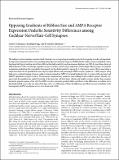| dc.contributor.author | Liberman, Leslie D. | |
| dc.contributor.author | Wang, Haobing | |
| dc.contributor.author | Liberman, M. Charles | |
| dc.date.accessioned | 2011-10-03T16:46:47Z | |
| dc.date.available | 2011-10-03T16:46:47Z | |
| dc.date.issued | 2011-01 | |
| dc.date.submitted | 2010-10 | |
| dc.identifier.issn | 0270-6474 | |
| dc.identifier.uri | http://hdl.handle.net/1721.1/66160 | |
| dc.description.abstract | The auditory system transduces sound-evoked vibrations over a range of input sound pressure levels spanning six orders of magnitude. An important component of the system mediating this impressive dynamic range is established in the cochlear sensory epithelium, where functional subtypes of cochlear nerve fibers differ in threshold sensitivity, and spontaneous discharge rate (SR), by more than a factor of 1000 (Liberman, 1978), even though, regardless of type, each fiber contacts only a single hair cell via a single ribbon synapse. To study the mechanisms underlying this remarkable heterogeneity in threshold sensitivity among the 5–30 primary sensory fibers innervating a single inner hair cell, we quantified the sizes of presynaptic ribbons and postsynaptic AMPA receptor patches in >1200 synapses, using high-power confocal imaging of mouse cochleas immunostained for CtBP2 (C-terminal binding protein 2, a major ribbon protein) and GluR2/3 (glutamate receptors 2 and 3). We document complementary gradients, most striking in mid-cochlear regions, whereby synapses from the modiolar face and/or basal pole of the inner hair cell have larger ribbons and smaller receptor patches than synapses located in opposite regions of the cell. The AMPA receptor expression gradient likely contributes to the differences in cochlear nerve threshold and SR seen on the two sides of the hair cell in vivo (Liberman, 1982a); the differences in ribbon size may contribute to the heterogeneity of EPSC waveforms seen in vitro (Grant et al., 2010). | en_US |
| dc.description.sponsorship | National Institute on Deafness and Other Communication Disorders (U.S.) (Grants RO1 DC0188) | en_US |
| dc.description.sponsorship | National Institute on Deafness and Other Communication Disorders (U.S.) (P30 DC5029) | en_US |
| dc.language.iso | en_US | |
| dc.publisher | American Chemical Society | en_US |
| dc.relation.isversionof | http://dx.doi.org/10.1523/jneurosci.3389-10.2011 | en_US |
| dc.rights | Creative Commons Attribution | en_US |
| dc.rights.uri | http://creativecommons.org/licenses/by/2.5/ | en_US |
| dc.source | PLoS | en_US |
| dc.title | Opposing gradients of ribbon size and AMPA receptor expression underlie sensitivity differences among cochlear-nerve/hair-cell synapses | en_US |
| dc.type | Article | en_US |
| dc.identifier.citation | Liberman, L. D., H. Wang, and M. C. Liberman. “Opposing Gradients of Ribbon Size and AMPA Receptor Expression Underlie Sensitivity Differences among Cochlear-Nerve/Hair-Cell Synapses.” Journal of Neuroscience 31 (2011): 801-808. | en_US |
| dc.contributor.department | Harvard University--MIT Division of Health Sciences and Technology | en_US |
| dc.contributor.approver | Liberman, M. Charles | |
| dc.contributor.mitauthor | Liberman, M. Charles | |
| dc.relation.journal | Journal of Neuroscience | en_US |
| dc.eprint.version | Final published version | en_US |
| dc.type.uri | http://purl.org/eprint/type/JournalArticle | en_US |
| eprint.status | http://purl.org/eprint/status/PeerReviewed | en_US |
| dspace.orderedauthors | Liberman, L. D.; Wang, H.; Liberman, M. C. | en |
| mit.license | PUBLISHER_CC | en_US |
| mit.metadata.status | Complete | |
